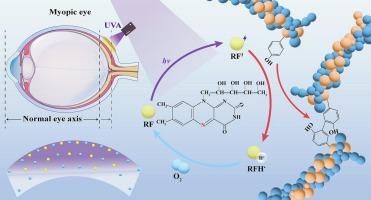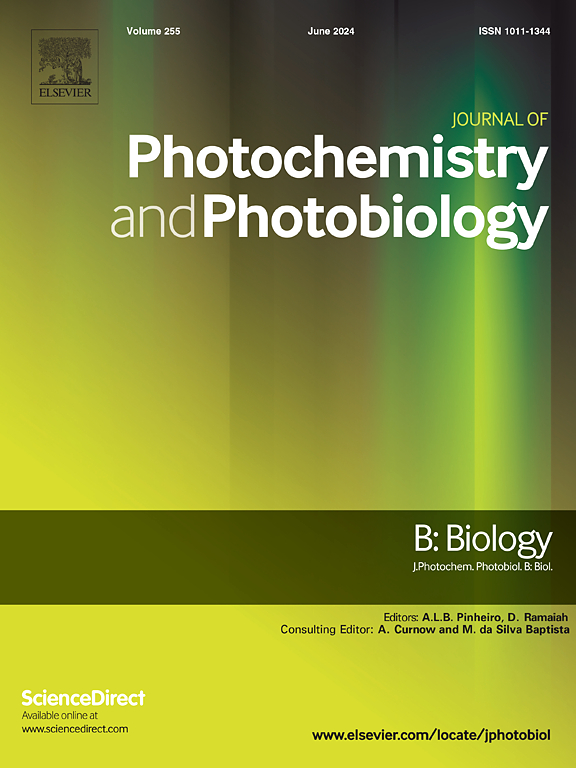A theoretical model for optimizing UVA/riboflavin crosslinking
IF 3.7
2区 生物学
Q2 BIOCHEMISTRY & MOLECULAR BIOLOGY
Journal of photochemistry and photobiology. B, Biology
Pub Date : 2025-09-25
DOI:10.1016/j.jphotobiol.2025.113272
引用次数: 0
Abstract
Ultraviolet-A and riboflavin (UVA/R) crosslinking has emerged as a valuable technique for ocular disease treatments. However, the exact influence of the oxygen and riboflavin on the crosslinking has not been fully explored so far. A kinetic model was developed to predict corneal/scleral stiffening effects under varying oxygen levels, irradiation intensities, and riboflavin solution concentrations during crosslinking at a fixed fluence. The optical properties of porcine sclera were determined by UV–Vis spectrophotometry. Monte Carlo method was employed to evaluate intrastromal light absorption of riboflavin. The roles of oxygen and riboflavin in the reaction mechanism were proposed based on the kinetic interactions of reactive species within the corneal/scleral stroma. Kinetic simulations indicated that increasing intrastromal oxygen concentration, driven by higher ambient oxygen levels, significantly improves crosslinking efficiency. The crosslinker formation rate reach its maximum when the intrastromal riboflavin concentration was approximately 0.245 %. Concentrations that are either too low or too high are adversely affect the formation of crosslinker. Optimal stiffening effects could be achieved by balancing oxygen availability, irradiation intensity, and riboflavin solution concentration. The model accuracy of oxygen prediction was verified by experimental results obtained from corneal crosslinking. Linear correlations were found between the model-predicted concentration of newly induced crosslinkers and the experimentally measured mechanical properties of both the cornea and sclera under various crosslinking protocols. Our study improved the prediction model by introducing accurate optical properties of the sclera. This proposed model provides a possibility for predicting the biomechanical crosslinking efficacy of the cornea/sclera, and may be used for optimizing UVA/R crosslinking protocols in customized treatment for ocular disease.

优化UVA/核黄素交联的理论模型
紫外- a与核黄素(UVA/R)交联已成为一种有价值的眼部疾病治疗技术。然而,氧和核黄素对交联的确切影响至今尚未得到充分的探讨。建立了一个动力学模型来预测不同氧水平、辐照强度和核黄素溶液浓度在固定通量交联过程中的角膜/巩膜硬化效应。采用紫外可见分光光度法测定了猪巩膜的光学性质。采用蒙特卡罗方法评价核黄素的细胞内光吸收。根据角膜/巩膜基质中反应物质的动力学相互作用,提出了氧和核黄素在反应机制中的作用。动力学模拟表明,在高环境氧水平的驱动下,增加星间氧浓度显著提高交联效率。当细胞内核黄素浓度约为0.245%时,交联剂形成率达到最大。浓度过低或过高都会对交联剂的形成产生不利影响。通过平衡氧可用性、辐照强度和核黄素溶液浓度可以达到最佳的硬化效果。角膜交联实验结果验证了模型预测氧含量的准确性。在不同交联方案下,模型预测的新诱导交联剂浓度与实验测量的角膜和巩膜力学性能之间存在线性相关。我们的研究通过引入准确的巩膜光学特性来改进预测模型。该模型为预测角膜/巩膜的生物力学交联效果提供了可能,并可用于优化UVA/R交联方案,用于眼科疾病的定制治疗。
本文章由计算机程序翻译,如有差异,请以英文原文为准。
求助全文
约1分钟内获得全文
求助全文
来源期刊
CiteScore
12.10
自引率
1.90%
发文量
161
审稿时长
37 days
期刊介绍:
The Journal of Photochemistry and Photobiology B: Biology provides a forum for the publication of papers relating to the various aspects of photobiology, as well as a means for communication in this multidisciplinary field.
The scope includes:
- Bioluminescence
- Chronobiology
- DNA repair
- Environmental photobiology
- Nanotechnology in photobiology
- Photocarcinogenesis
- Photochemistry of biomolecules
- Photodynamic therapy
- Photomedicine
- Photomorphogenesis
- Photomovement
- Photoreception
- Photosensitization
- Photosynthesis
- Phototechnology
- Spectroscopy of biological systems
- UV and visible radiation effects and vision.

 求助内容:
求助内容: 应助结果提醒方式:
应助结果提醒方式:


